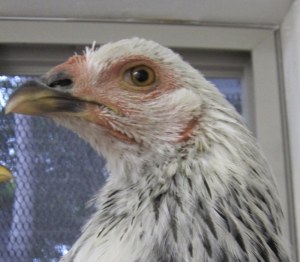The CE and I headed out to Camino Real for lunch today at one of our new favorite places, the Hollister Brewing Company. Varied menu, lots of comfort food. Very casual, kind of sports-bar-like inside with multiple tv screens on the walls, but well-lit and there’s also seating on the outdoor terrace. Always an interesting selection of micro-brews for the beer afficionados, too.

After lunch, we noticed there was a bustling Farmers Market set up in the Marketplace so off I went in search of treats for the chickens. While purchasing some Swiss chard I mentioned to the vendor that it was for my chickens. He signaled me to wait a moment and returned with two large handfuls of carrot tops, gratis. The chickens found these much less threatening than yesterday’s apples.

Hope enjoys the carrot greens
Since the dogs had been home alone for a full two hours, we decided to appease them with an outing, so we took them over to the Laguna Blanca School field for a walk.

Soho lets her hair down

Outlaw Chloe
I let the chickens free-range a bit when we returned home, and noticed how prominent Hope’s comb and wattle have become. According to anecdotal wisdom, comb and wattle development and color go along with a hen’s readiness to lay eggs, so my money is on Hope to be the first of the girls to lay. None of the others seem to anywhere near her in the comb/wattle department.

Amelia has a small comb starting above her beak

Not much going on with Lily, comb-wise

Autumn still just looks like Groucho Marx - no comb or wattle

But look at Hope - way ahead of the pack!
Lily, like Hope, will have what is referred to as a “single” comb. This is by far the most common comb found across the various breeds of chickens. Autumn and Amelia will have the smaller and somewhat less common “pea” comb.

Chart of comb types found at hubpages.com/hub/Taming-Wild-Roosters
The Latin name for chicken is Gallus gallus domesticus. According to Backyard Poultry magazine, gallus is the Latin word for comb, elsewhere it is described as the Latin word for cockerel, or young rooster. Either way, the comb is clearly indicated. I guess this tells us something about what the Romans thought of the inhabitants of Gaul, which by today’s geographic boundaries encompasses France and Belgium.
Another thing to note in the close-up mug shots of the four girls is that it is also anecdotally suggested that the color of a hen’s earlobe indicates the color of egg she will lay. Chickens with white earlobes will most likely lay white or light-tinted eggs; those with red earlobes most commonly lay brown eggs. We likely still have four to eight weeks before we find out.

I am a little disappointed that Autumn will only have a pea comb…but maybe it will go perfectly with her lovely feather collar. I had to glance back a few times to try to locate the chickens’ earlobes. Couldn’t really see Autumns. Later I thought, “WOW, I can locate a chicken’s earlobe.” That is quite something!
I think that makes you a chicken expert!
Go Hope!